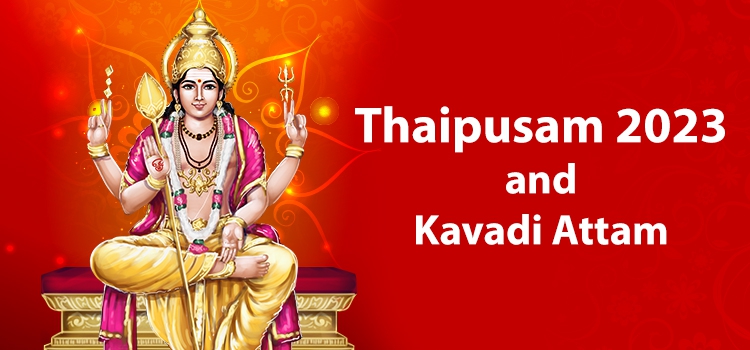Thaipusam 2023 : Kavadi Attam Celebrations
Thaipusam is a festival of the Tamil Hindu community in India. It falls on the full moon in the Tamil month of Thai (January-February). On this day, the star Pusam is at its highest point.
Thaipusam is a major event in Murugan temples. Murugan is the son of Shiva and Parvati. Mythology says that on Thaipusam day, Parvati gave Murugan a Vel (spear) to kill the demon, Tarakasura, and his army. Thaipusam 2023 is on February 5, a Sunday.
Tamils in countries like Singapore, Malaysia, Sri Lanka, Fiji, USA, UK, Canada, South Africa, etc., also celebrate the festival with great enthusiasm.

History of Thaipusam
Shiva told Sage Agastya to take two hills — Sivagiri and Saktigiri – to the South. The sage asked his disciple, the demon, Idumban, to carry out the task. Idumban was one of the survivors of the battle between Murugan’s forces and those of Surapadman, the brother of Tarakasura. After the war, he became a devotee of Murugan.
At this time, Muruga had been defeated by his brother Ganesha in a contest that involved going around the world. He was still upset about it. In a fit of anger, he decided to leave his home and family. He descended to earth at Tiru Avinankudi at the Adivāram (meaning ‘foot of the Sivagiri Hill’). But later, he went to the Palani hills and settled down there as a recluse.
Idumban carried the hills on his shoulders after suspending them with ropes on either side of a wooden beam. During the journey south, he felt tired and rested for a while at Palani. But when he tried to resume his journey, he could not lift the hills. Murugan wanted to test Idumban’s determination and devotion to his guru, so he made it impossible for Idumban to lift the burden.
On the hilltop, the demon saw a young lad wearing only kaupeenam (loin cloth) and told him to leave at once so that Idumban could proceed with his task. The boy refused. A fierce battle ensued, and Idumban was slain. But on Sage Agastya’s request, the boy, who was Muruga himself, restored him to life.
Idumban realized that the boy was his Ishta Devata, Murugan, and asked him for 2 wishes:
- That any person who carried on their shoulders the Kavadi, representing the two hills, and visited the temple at Palani on a vow should be blessed.
- That he should have the privilege of standing guard at the entrance to the hill.
- It was after this that pilgrims to Palani began to carry Kavadis containing their offerings to Murugan on their shoulders. The custom eventually spread to all Murugan temples.
The Significance of Kavadi
- The Kavadi carried by devotees symbolize their burdens in life, like the two hills that Idumban carried.
- The belief is that the burdens in the life of the devotees who carry Kavadi are lessened due to Murugan’s grace.
- Carrying Kavadi to Murugan temples during Thaipusam is very auspicious.
Preparations by Kavadi Bearers
Kavadi bearers begin to prepare for the ritual 48 days (one mandala) before Thaipusam. They observe several austerities to become mentally and physically pure. These include:
- Trying to control the senses
- Observing a complete fast. Some have only one simple vegetarian meal a day. Others have fruits and milk only.
- Not smoking cigarettes, drinking alcohol, or using other intoxicants
- Not having sex
- Taking baths in cold water
- Not shaving or cutting hair (for men)
- Going to sleep on the floor
- Performing Poojas, offering prayers, doing Japa, chanting mantras, singing hymns, reading spiritual books, and thinking constantly of Murugan.
After completing the 48-day austerities, the Kavadi bearers also observe a total fast 24 hours before Thaipusam. Some observe a vow of silence, too. After a purificatory bath, they wear orange or yellow clothes and walk barefoot to the Murugan temple carrying the Kavadis with their offerings.
Those who carry the Kavadi or pull chariots with hooks attached to their bodies are accompanied by other devotees who play musical instruments like the Tavil (Indian drum) and nadaswaram (Indian trumpets). They also sing Thirupugazh, Kandar Anubhuti, Kavadi Sindhu, and other devotional songs on Muruga. All this creates a spiritually charged atmosphere. They also chant ‘Vel Vel Muruga’ or ‘Kandanukku Arogara’ as they walk.
Rituals Performed at the Temple
· Male devotees shave their head and beard and offer it as Kanikkai to Murugan. They also take a ritual bath before visiting the temple.
· Male devotees often perform Ashtanga Namaskaram and Angapradakshina (rolling over the floor).
· Female devotees do not need to shave their heads.
· Female devotees do Panchanga Namaskaram. But the Sastras forbid them to do Ashtanga Namaskaram and Angapradakshinam.
Types of Kavadi
Theertha/ Panneer Kavadi
Devotees carry a pot of sanctified water or rose water, which is used to perform Abishekam to Murugan.
Paal Kavadi
Devotees carry pots filled with milk.
Alangara Kavadi
The Kavadi is decorated with peacock feathers, an image of Murugan, and other religious symbols.
Pushpa Kavadi
This Kavadi is decorated with various flowers.
Kavadi bearers often pierce their tongue and cheeks with a small spear.
Karumbu Toddi
When prayers for a child are answered, as a token of gratitude, married couples carry their child in a bundle held by a pole of sugar cane. They also tonsure the child’s head ceremonially and smear the shaved head with sandal paste.
Kavadi Attam
Kavadi Attam means ‘burden dance’ literally. The Kavadi bearers perform a dance while carrying their Kavadis, which is the Kavadi attam. It is essentially a ceremonial sacrifice and offering to Murugan.
Devotees make vows and choose the thanksgiving offering. It could be something simple like carrying a Paal Kavadi (a wooden pole with pots of milk hanging at each end), or they may drag a chariot with hooks pierced through their bodies or carry an ornate structure held by spikes that are pierced into their skin. Before the pilgrimage begins, volunteers help fix the Kavadis to the devotee’s body.



















